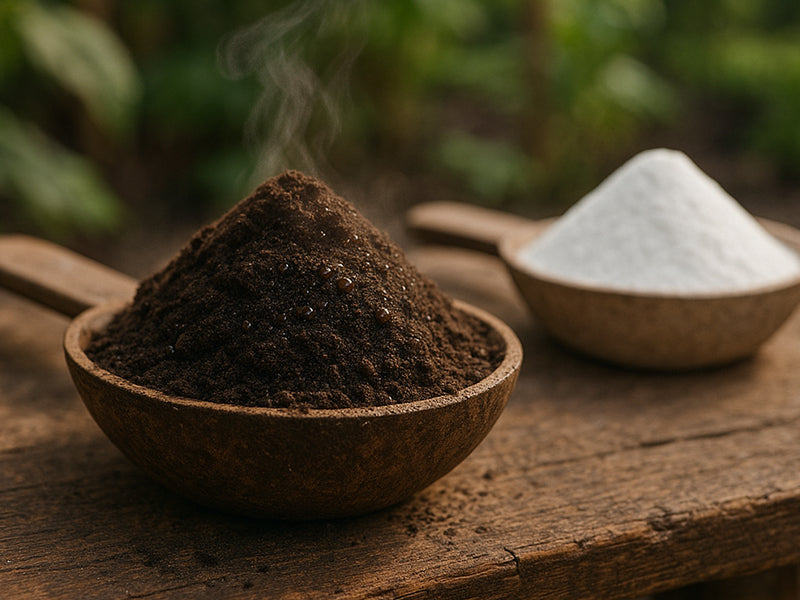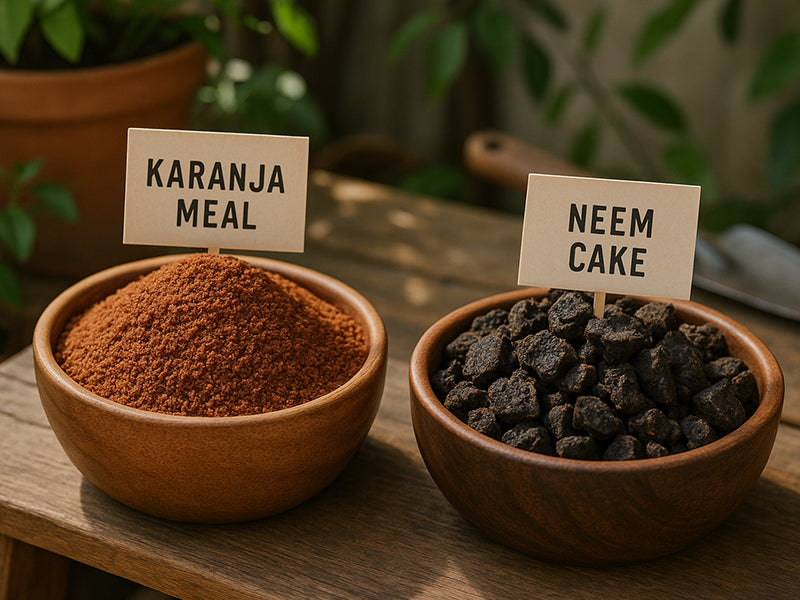In the world of hydroponic supplements and industry jargon, it can be challenging to discern the differences between seemingly similar substances at a casual glance. However, when given more than a side eye, they couldn't be more striking in their differences in the context of Living soil or a Biologically functioning system.
In short, it's ALL ABOUT THE YAN! (Yeast Assimilable Nitrogen)
What is Y.A.N.?
Yeast Assimilable Nitrogen. This type of nitrogen is readily used by Yeast (one of the first steps in organic matter breakdown). YAN includes free amino acids, ammonium ions, and small peptides.
In the context of plant growth and soil health, YAN is crucial because it represents the forms of nitrogen that can be quickly assimilated by soil microbes and plants, without causing negative effect on soil microflora (because the soil food web recognizes it - it actually boosts it!). High YAN levels in fertilizers and supplements ensure that plants AND microbes, receive the essential nitrogen they need in an easily accessible form, leading to better nutrient uptake and overall plant health, but also a more lively soil food web.
Now back to Amino Acid Chelates
Often, you'll see, in the race for Big Agriculture to rebrand itself from "pharmaceutical grade salts" to "organic", terms like "Amino acid chelated base minerals" thrown around and thought "Yeah, Aminos, I've heard they are organic and good for soil", or "I've heard Amino Acid chelates are more easily uptaken by plants."
You may have looked at said offerings compared with a Full-Amino Acid product like our AQUA-MARINE and thought, "Well, what's the difference?" they both sound similar?
While these things sound similar on the surface, they are quite different. But to get to what an Amino Acid Chelate isn't, we've got to first sum up all that it is!
So what is an Amino acid-chelated mineral then?
In short, an Amino Acid Chelate is simply an amino Acid. Usually Glycine bonded to a mineral then forming a chemical bond with it and turning it into a Glycinate.
Now, what this means is when this mineral (whatever it may be) enters the plant, the plant receives the Mineral portion, attached to Glycine, which it can then cleave off for some internal processes (usually conversion to sugar = food)
Now it gets interesting.
What's worth noting is that Amino Acid Chelates are not whole amino acids, and they are not YAN!
The plant may more easily absorb them than conventional unchelated salts, but they do next to nothing for building your soil and are NOT complete amino acid products. One amino Acid by itself (Glycine) bonded to (Mineral ) does not make a complete plant booster.
What is being done here is a little bit of sleight of hand. These products are NOT complete amino acid-based fertilisers, but they are trying to elude that what they are providing has the same benefits.
These Amino Acid Chelate products only provide Glycine (solely) as a side contribution, so at most, you get Glycine in addition to whatever mineral it is bonded to (usually Glycine is picked as it is the smallest amino and therefore easiest to piggyback other minerals onto but..... Glycine is also the cheapest and most widely available single amino acid....) so it is more chosen usually because it is cost-effective, rather than the fact there wouldn't be better potential Amino Acid pairings (Such as Glutamic bonds, for example, more effective but far more expensive).
In this context, the smallest, most readily absorbed, but also cheapest amino acid is chosen to bond these salt based fertilisers to, making them more easily absorbed. Let's call it a mild shuffle in the right direction, but far from what we're on about here at HPO.
It is not a soil food, so it is more applicable to Hydroponics than Soil, as it is so often marketed towards.
Now, stick with me. This will make more sense soon. Let's look at two examples of products:
One is a 3-1-2 N.P.K. Amino Acid Chelate product.
One is a 3-1-2 N.P.K FULL AMINO ACID product.
Both of these fertilisers contain 3% Nitrogen, 1% Phosphorous and 2% Potassium, meaning each one delivers - on analysis.
- 300ppm Nitrogen
- 100ppm Phosphorous
- 200ppm Potassium
One is an Amino Acid Chelate, meaning that at most, in addition to your above elements, you get a small amount of tacked on Glycine.
All of these are not YAN, and they do not feed your soil in any appreciable way. They are all bells and whistles aside, just salts.
Yes, these Amino Acid Chelates contain Glycine, an amino acid, and yes, Amino Acid Chelates are more easily absorbed by plants than just straight elements.
But that is EXACTLY where the benefits begin and end. Right there.
You get (Element + Glycine), which your plant finds beneficial purely in the reductive "It gets a certain amount of P.P.M. in the most efficient way (and yes, that includes cost) possible".
Now, if you compare a 3-1-2 product that is a Complete Amino Acid Fertiliser like our AQUA-MARINE, this also delivers you:
- 300ppm Nitrogen
- 100ppm Phosphorous
- 200ppm Potassium
However, it comes in base of Total and complete protein amino acids, so what that means is the entire spectrum of Amino Acids - all of them.
Essential Amino Acids (9)
- Histidine
- Isoleucine
- Leucine
- Lysine
- Methionine
- Phenylalanine
- Threonine
- Tryptophan
- Valine
Non-Essential Amino Acids (11)
- Alanine
- Arginine
- Asparagine
- Aspartic Acid
- Cysteine
- Glutamic Acid
- Glutamine
- Glycine
- Proline
- Serine
- Tyrosine
They are all in forms that are easily assimilated by Soil Microbes—all of which are YAN, meaning they all contribute directly to plant growth and boost soil simultaneously.
The doses of these Amino acids in a product like this dwarfs the amount of Glycine in an Amino Acid Chelate to an enormous degree, and delivers 19 other Amino-Acids as well.
Amino acids, all in different concentrations and P.P.M.'s, have drastic effects on plant growth, and this is arguably why Amino Acid products have such great effects on plant growth and health.
So lets do some comparisons:
Brand X - Amino Acid Chelate 3-1-2 gives you this for each Gram of product:
- 30mg Nitrogen, 10mg Phosphorous, 20mg Potassium
- 18mg Glycine (given that 30% is the max that can be bonded in an L-Glycine chelate bond). This is a generous assumption.
- And.....Water
None of which is YAN - absorbed by plants, yes, but not considered microbial food!
So of your whole Gram of 3-1-2 Amino Acid Chelate fertilser you get a whole......78mg of actual actives - and 922mg of........water.
Given that most liquid nutrients have about the bulk density of water (because they are close to 95% water), you can assume that of the 1L bottle (1000 grams) you buy, You get 922mls of water and 78g of Amino Acid Chelate, 18g (at most) is L-Glycine.
Which is why most multi-bottle programs also recommend a separate Amino Acid product. Or supplement containing Aminos.
Brand Y - Complete Amino Acid 3-1-2 gives you this for each Gram of product:
- 30mg Nitrogen, 10mg Phosphorous, 20mg Potassium
- up to 796mg Full Spectrum Amino acids & Peptides (All Able to be assimilated by Yeast - YAN)
- 144mg Carbon (Carbohydrates - more soil food).
So, if you look at it this way out of 1000mg:
- 1000mg! total of "stuff plants use"
- 60mg NPK
- up to 796mg Total Amino Acids All of which are YAN
- + 144mg Minimum Carbon
It's easy to see how one product delivers you FAR more for your dollar, than the other. One feeds your plants, and not much else, the other feeds your plants, boosts your plants AND boosts your soil.
Shameless plug:
Given that our AQUA-MARINE are analyzed at even higher than the 3-1-2 suggested here, a 0.5g dose of our fertiliser provides the benefits you would need multiple different bottles to get close to the effectiveness of.
Even when using competing products, the ratios of individual amino acids we have calculated for each of these H.P.O. products (AQUA-MARINE Grow and Bloom) formulas are such that each formulation, supports each phase of growth, from a Biochemical standpoint, at the amino acid faciliatory level— not just at the NPK level.
Food for thought. Happy Growing!



